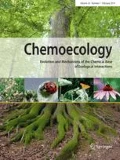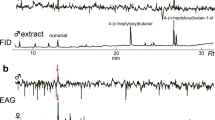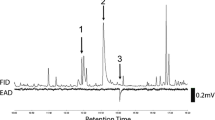Abstract
Insects in several orders deposit marking pheromones following oviposition. In addition to preventing the female from visiting the same site again, the pheromone also signals the presence of eggs to conspecific females. This form of chemical marking is particularly prevalent in species which oviposit on discrete hosts with limited resources available for developing larvae. The pepper weevil is a major pest of cultivated pepper throughout the southern United States, Mexico and the Caribbean. The weevil deposits eggs singly in a cavity chewed in flower buds and small fruits and caps these cavities with a plug derived from an anal secretion. The deterrent was found to be located in this oviposition plug and comprised of volatile and contact-acting components. Plug volatiles were collected by inducing oviposition into Teflon tape sachets containing pepper leaves and collecting volatiles from plugs laid on the tape surface. Of the two major components observed by GC/MS analyses, only acetophenone elicited a behavioral response by the female weevil in small arena and wind tunnel assays. Investigations of the oviposition plug matrix identified several free unsaturated and saturated fatty acids as major constituents of the plug which was in stark contrast to pepper tissue and seeds that contained only trace levels of free fatty acids and a distinctly different total fatty acid composition. The combined free fatty acids as well as acetophenone tested singly gave no significant reduction in oviposition while a plug-mimicking blend of unsaturated fatty acids tested in combination with acetophenone as artificial ‘plug spots,’ decreased oviposition on treated peppers by up to 75%. We propose that the combination of volatile and contact acting marking components improves oviposition site selection efficiency by pepper weevils on discrete hosts.



Similar content being viewed by others
Availability of data and materials
Upon request.
Code availability
Not applicable
References
Addesso KA, McAuslane HJ, Stansly PA, Schuster DJ (2007) Host-marking by female pepper weevils, Anthonomus eugenii. Entomol Exp Appl 125:269–327
Addesso KA, McAuslane HJ, Alborn HT (2011) Attraction of pepper weevil to volatiles from damaged pepper plants. Entomol Exp Appl 138:1–11
Alborn HT (2018) A technique for thermal desorption analyses suitable for thermally labile, volatile compounds. J Chem Ecol 44:103–110
Anderson P (2002) Oviposition pheromones in herbivorous and carnivorous insects. In: Hilker M, Meiners T (eds) Chemoecology of insect eggs and egg deposition. Blackwell, Berlin, pp 235–264
Atlas EL, Sullivan KF, Giam CS (1985) Preconcentration of atmospheric organic compounds by heat desorption and solvent microextraction. Anal Chem 57:2417–2419
Blaakmeer A, Hagenbeek D, van Beek TA, de Groot AE, Schoonhoven LM, van Loon JJA (1994) Plant response to eggs vs. host marking pheromone as factors inhibiting oviposition by Pieris brassicae. J Chem Ecol 20:1657–1665
Bunchu N, Sukontason KL, Olson JK, Sukontason KH, K, (2008) Behavioral responses of Chrysomya megacephala to natural products. Parasitol Res 102:419–429
Calderon-Limon BA, Garcia-Hernandez JL, Troyo-Dieguez E (2002) Technique for oviposition of the pepper weevil (Coleoptera: Curculionidae) to obtain massive colonies in the laboratory. Folia Entomol Mex 41:249–251
Credland PF, Wright AW (1990) Oviposition deterrents of Callosobruchus maculates. Physiol Entomol 15:285–298
El-Sayed AM (2014) The Pherobase: Database of Pheromones and Semiochemicals. http://www.pherobase.com
Elmore JC, Davis AC, Campbell RE (1934) The pepper weevil. USDA Technical. Bulletin 310:27
Engelbert J, Schmelz EA, Alborn HT, Cardoza YJ, Huang J, Tumlinson JH (2003) Simultaneous quantification of jasmonic acid and salicylic acid in plants by vapor-phase extraction and gas chromatography-chemical ionization-mass spectrometry. Anal Biochem 312:242–250
Everett TR, Earle NW (1964) Boll weevil oviposition responses in cotton squares and various other substances. J Econ Entomol 57:651–656
Fatouros NE, Lucus-Barbosa D, Weldegergis BT, Pashalidou FG, van Loon JJA, Dicke M, Harvey JA, Gols R, Huigens ME (2012) Plant volatiles induced by herbivore egg deposition affect insects of different trophic levels. PLoS ONE. https://doi.org/10.1371/journal.pone.0043607
Feussner I, Wasternack C (2002) The lipoxygenase pathway. Annu Rev Plant Biol 53:275–297
Hedin PA, Gueldner RC, Henson RD, Thompson AC (1974) Volatile constituents of male and female boll weevils and their frass. J Insect Physiol 20:2135–2142
Kozlowski MW, Lux S, Dmoch J (1983) Oviposition behaviour and pod marking in the cabbage seed weevil, Ceutorhynchus assimilis. Entomol Exp Appl 34:277–282
Kumazaki M, Matsuyama S, Suzuki T, Kuwahara Y, Fujii K (2000) Parasitic wasp, Dinarmus basalis, utilizes oviposition marking pheromone of host azuki bean weevils as host recognizing kairomone. J Chem Ecol 26:2677–2695
Mast JD, De Moraes CM, Alborn HT, Lavis LD (2014) Stern DL (2014) Evolved differences in larval social behavior mediated by novel pheromones. Elife 3:e04205
Messina FJ, Renwick JAA (1985) Ability of ovipositing seed beetles to discriminate between seeds with differing egg loads. Ecol Entomol 10:225–230
Mitchell HC, Cross WH (1969) Oviposition by the boll weevil in the field. J Econ Entomol 62:604–605
Nufio CR, Papaj DR (2001) Host marking behavior in phytophagous insects and parasitoids. Entomol Exp Appl 99:273–293
Ofuya T, Agele S (1989) Ability of ovipositing Callosobruchus maculatus females to discriminate between seeds bearing their own eggs and those bearing eggs of other females. Ecol Entomol 14:243–246
Parr MJ, Tran BMD, Simmonds MSJ, Kite GC, Credland PF (1998) Influence of some fatty acids on oviposition by the bruchid beetle, Callosobruchus maculates. J Chem Ecol 24:1577–1593
Prokopy RJ (1981) Epideictic pheromones that influence spacing patterns of phytophagous insects. In: Nordlund DA, Jones RL, Lewis WJ (eds) Semiochemicals: their role in pest control. Wiley Press, New York, pp 181–213
Rausher MD (1979) Egg recognition: Its advantage to a butterfly. Anim Behav 27:1034–1040
Speranza S, Colonnelli E, Garonna AP, Laudonia S (2014) First record of Anthonomus eugenii (Coleoptera: Curculionidae) in Italy. Fla Entomol 97:844–845
Stansly PA, Cate JR (1984) Discrimination by ovipositing boll weevils (Coleoptera: Curculionidae) against previously infested Hampea (Malvaceae) flower buds. Environ Entomol 13:1361–1365
Stuhl C, Sivinski J, Teal PEA, Paranhos B, Aluja M (2011) A compound produced by Fruigivorous Tephritidae (Diptera) larvae promotes oviposition behavior by the biological control agent Diachasmimorpha longicaudata (Hymenoptera: Braconidae). Environ Entomol 40:727–736
Thiéry D, Gabel B, Farkas P, Pronier V (1992) Identification of an oviposition-regulating pheromone in the European grapevine moth Lobesia botrana (Lepidoptera: Tortrieidae). Experientia 48:697–699
Thiéry D, Gabel B, Farkas P, Pronier V, Jarry M (1995) Egg dispersion in coddling moth: influence of egg extracts and of its fatty acid constituents. J Chem Ecol 21:2015–2223
Visser B, Willett DS, Harvey JA, Alborn HT (2017) Concurrence in the ability for lipid synthesis between life stages of insects. Royal Society Open Sci 4:160815
Acknowledgments
The authors would like to thank Casey Reed for assistance in rearing pepper weevils and Bevin Forguson for aiding in pepper plant and fruit production. The use of trade, firm, or corporation names in this publication is for information and convenience of the reader. Such use does not constitute an official endorsement or approval by the United States Department of Agriculture or the Agricultural Research Service of any product or service to the exclusion of others that may be suitable. USDA is an equal opportunity provider and employer.
Funding
This work was partially performed under USDA-ARS Project # 6036–11210-001-00D.
Author information
Authors and Affiliations
Contributions
All authors contributed equally to the research.
Corresponding author
Ethics declarations
Conflicts of interest
Not applicable.
Consent to participate
Not applicable.
Consent for publication
Not applicable.
Ethics approval
Not applicable.
Additional information
Communicated by Günther Raspotnig.
Rights and permissions
About this article
Cite this article
Addesso, K.M., Alborn, H.T., Bruton, R.R. et al. A multicomponent marking pheromone produced by the pepper weevil, Anthonomus eugeni (Coleoptera: Curculionidae). Chemoecology 31, 247–258 (2021). https://doi.org/10.1007/s00049-021-00347-3
Received:
Accepted:
Published:
Issue Date:
DOI: https://doi.org/10.1007/s00049-021-00347-3




